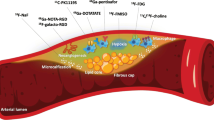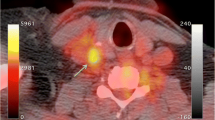Abstract
The emphasis of current cardiovascular imaging modalities is on the anatomic detection of coronary artery luminal narrowing. However, in the clinical setting, vulnerable plaques that are not flow limiting may account for the majority of cardiovascular events. Thus, the pursuit for developing noninvasive imaging techniques that target vulnerable plaques is a laudable goal. Recent studies have demonstrated the clinical feasibility of direct visualization and characterization of coronary and carotid artery plaques with 18F-fluorodeoxyglucose (FDG) positron emission tomography imaging. In experimental studies, the intensity of FDG uptake has been shown to correlate with macrophage density and inflammatory state of plaques. Vascular plaque FDG uptake has been linked to cardiovascular events such as myocardial infarction and stroke. Anti-inflammatory drugs and statins have been shown to attenuate FDG uptake in plaques. Thus, the identification of FDG uptake in vascular plaques may have important clinical implications for predicting and preventing future cardiovascular events.

Similar content being viewed by others
References
Papers of particular interest, published recently, have been highlighted as: •Of importance
Ambrose JA, Tannenbaum MA, Alexopoulos D, et al.: Angiographic progression of coronary artery disease and the development of myocardial infarction. J Am Coll Cardiol 1988, 12:56–62.
Little WC, Constantinescu M, Applegate RJ, et al.: Can coronary angiography predict the site of a subsequent myocardial infarction in patients with mild-to-moderate coronary artery disease? Circulation 1988, 78:1157–1166.
Fuster V, Badimon L, Badimon JJ, et al.: The pathogenesis of coronary artery disease and the acute coronary syndromes. N Engl J Med 1992, 326:242–250.
Myerburg RJ: Sudden cardiac death in persons with normal (or near normal) hearts. Am J Cardiol 1997, 79:3–9.
Glagov S, Weisenberg E, Zarins CK, et al.: Compensatory enlargement of human atherosclerotic coronary arteries. N Engl J Med 1987, 316:1371–1375.
Motoyama S, Kondo T, Sarai M, et al.: Multislice computed tomographic characteristics of coronary lesions in acute coronary syndromes. J Am Coll Cardiol 2007, 50:319–326.
Raman SV, Winner MW 3rd, Tran T, et al.: In vivo atherosclerotic plaque characterization using magnetic susceptibility distinguishes symptom-producing plaques. JACC Cardiovasc Imaging 2008, 1:49–57.
Chen W, Bural GG, Torigian DA, et al.: Emerging role of FDG-PET/CT in assessing atherosclerosis in large arteries. Eur J Nucl Med Mol Imaging 2009, 36:144–151.
Dilsizian V, Narula J: Putting the face to a name: concurrent assessment of vascular morphology and biology. J Am Coll Cardiol Imaging 2009, 2:1243–1244.
Théron J, Tyler JL: Takayasu’s arteritis of the aortic arch: endovascular treatment and correlation with positron emission tomography. AJNR Am J Neuroradiol 1987, 8:621–626.
Yun M, Jang S, Cucchiara A, et al.: 18F FDG uptake in the large arteries: a correlation study with the atherogenic risk factors. Semin Nucl Med 2002, 32:70–76.
Tatsumi M, Cohade C, Nakamoto Y, et al.: Fluorodeoxyglucose uptake in the aortic wall at PET/CT: possible finding for active atherosclerosis. Radiology 2003, 229:831–837.
Ben-Haim S, Kupzov E, Tamir A, et al.: Evaluation of 18F-FDG uptake and arterial wall calcifications using 18F-FDG PET/CT. J Nucl Med 2004, 45:1816–1821.
Dunphy MP, Freiman A, Larson SM, et al.: Association of vascular 18F-FDG uptake with vascular calcification. J Nucl Med 2005, 46:1278–1284.
Ogawa M, Ishino S, Mukai T, et al.: (18)F-FDG accumulation in atherosclerotic plaques: immunohistochemical and PET imaging study. J Nucl Med 2004, 45:1245–1250.
Tawakol A, Migrino RQ, Hoffmann U, et al.: Noninvasive in vivo measurement of vascular inflammation with F-18 fluorodeoxyglucose positron emission tomography. J Nucl Cardiol 2005, 12:294–301.
Zhang Z, Machac J, Helft G, et al.: Non-invasive imaging of atherosclerotic plaque macrophage in a rabbit model with F-18 FDG PET: a histopathological correlation. BMC Nucl Med 2006, 6:3–10.
Davies JR, Izquierdo-Garcia D, Rudd JH, et al.: FDG-PET can distinguish inflamed from non-inflamed plaque in an animal model of atherosclerosis. Int J Cardiovasc Imaging 2009 Sep 22 (Epub ahead of print).
Rudd JH, Warburton EA, Fryer TD, et al.: Imaging atherosclerotic plaque inflammation with [18F]-fluorodeoxyglucose positron emission tomography. Circulation 2002, 105:2708–2711.
Tawakol A, Migrino RQ, Bashian GG, et al.: In vivo 18F-fluorodeoxyglucose positron emission tomography imaging provides a noninvasive measure of carotid plaque inflammation in patients. J Am Coll Cardiol 2006, 48:1818–1824.
Ogawa M, Magata Y, Kato T, et al.: Application of 18F-FDG PET for monitoring the therapeutic effect of antiinflammatory drugs on stabilization of vulnerable atherosclerotic plaques. J Nucl Med 2006, 47:1845–1850.
Tahara N, Kai H, Ishibashi M, et al.: Simvastatin attenuates plaque inflammation: evaluation by fluorodeoxyglucose positron emission tomography. J Am Coll Cardiol 2006, 48:1825–1831.
Crisby M, Nordin-Fredriksson G, Shah PK, et al.: Pravastatin treatment increases collagen content and decreases lipid content, inflammation, metalloproteinases, and cell death in human carotid plaques: implications for plaque stabilization. Circulation 2001, 103:926–933.
Lee SJ, On YK, Lee EJ, et al.: Reversal of vascular 18F-FDG uptake with plasma high-density lipoprotein elevation by atherogenic risk reduction. J Nucl Med 2008, 49:1277–1282.
Davies JR, Rudd JH, Fryer TD, et al.: Identification of culprit lesions after transient ischemic attack by combined 18F Fluorodeoxyglucose positron-emission tomography and high-resolution magnetic resonance imaging. Stroke 2005, 36:2642–2647.
Arauz A, Hoyos L, Zenteno M, et al.: Carotid plaque inflammation detected by 18F-fluorodeoxyglucose-positron emission tomography. Pilot study. Clin Neurol Neurosurg 2007, 109:409–412.
• Paulmier B, Duet M, Khayat R, et al.: Arterial wall uptake of fluorodeoxyglucose on PET imaging in stable cancer disease patients indicates higher risk for cardiovascular events. J Nucl Cardiol 2008, 15:209–217. This retrospective study showed that vascular FDG uptake can be linked to cardiovascular events in humans.
• Alexanderson E, Slomka P, Cheng V, et al.: Fusion of positron emission tomography and coronary computed tomographic angiography identifies fluorine 18 fluorodeoxyglucose uptake in the left main coronary artery soft plaque. J Nucl Cardiol 2008, 15:841–843. This is an excellent case report showing coronary artery plaque FDG uptake.
• Wykrzykowska J, Lehman S, Williams G, et al.: Imaging of inflamed and vulnerable plaque in coronary arteries with 18F-FDG PET/CT inpatients with suppression of myocardial uptake using a low-carbohydrate, high-fat preparation. J Nucl Med 2009, 50:563–568. This paper shows evidence that myocardial background uptake can be suppressed by a high-fat, low-carbohydrate diet.
Buther F, Dawood M, Stegger L, et al.: List mode-driven cardiac and respiratory gating in PET. J Nucl Med 2009, 50:674–681.
Rudd JH, Myers KS, Bansilal S, et al.: (18)Fluorodeoxyglucose positron emission tomography imaging of atherosclerotic plaque inflammation is highly reproducible: implications for atherosclerosis therapy trials. J Am Coll Cardiol 2007, 50:892–896.
Menezes LJ, Kotze CW, Hutton BF, et al.: Vascular inflammation imaging with 18F-FDG PET/CT: when to image? J Nucl Med 2009, 50:854–857.
Isobe S, Tsimikas S, Zhou J, et al.: Noninvasive imaging of atherosclerotic lesions in apolipoprotein E-deficient and low-density-lipoprotein receptor-deficient mice with annexin A5. J Nucl Med 2006, 47:1497–1505.
Zhao Y, Kuge Y, Zhao S, et al.: Comparison of 99mTc-annexin A5 with 18F-FDG for the detection of atherosclerosis in ApoE-/- mice. Eur J Nucl Med Mol Imaging 2007, 34:1747–1755.
Kietselaer BL, Reutelingsperger CP, Heidendal GA, et al.: Noninvasive detection of plaque instability with use of radiolabeled annexin A5 in patients with carotid-artery atherosclerosis. N Engl J Med 2004, 350:1472–1473.
Winter PM, Morawski AM, Caruthers SD, et al.: Molecular imaging of angiogenesis in early-stage atherosclerosis with alpha(v)beta3-integrin-targeted nanoparticles. Circulation 2003, 108:2270–2274.
Laitinen I, Saraste A, Weidl E: Evaluation of alphavbeta3 integrin-targeted positron emission tomography tracer 18F-galacto-RGD for imaging of vascular inflammation in atherosclerotic mice. Circ Cardiovasc Imaging 2009, 2:331–338.
Wu YW, Kao HL, Chen MF, et al.: Characterization of plaques using 18F-FDG PET/CT in patients with carotid atherosclerosis and correlation with matrix metalloproteinase-1. J Nucl Med 2007, 48:227–233.
Disclosure
No potential conflicts of interest relevant to this article were reported.
Author information
Authors and Affiliations
Corresponding author
Rights and permissions
About this article
Cite this article
Chen, W., Dilsizian, V. 18F-Fluorodeoxyglucose PET Imaging of Coronary Atherosclerosis and Plaque Inflammation. Curr Cardiol Rep 12, 179–184 (2010). https://doi.org/10.1007/s11886-010-0095-8
Published:
Issue Date:
DOI: https://doi.org/10.1007/s11886-010-0095-8




